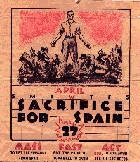|
Types of Primary Sources |
|
|
Basic Resources Learn More NYS Standards |
Published Documents | Unpublished DocumentsOral Traditions/Histories | Visual Documents/Artifacts | Unpublished Documents Oral Traditions/Histories | Visual Documents/Artifacts When analyzing primary sources, historians consider the type of primary source under study. Different primary sources were created for different reasons. Knowing the different types of primary sources will help you evaluate the reliability of primary sources. Read about the different types of primary sources below. Primary and Secondary SourcesHistorians use a wide variety of sources to answer questions about the past. In their research, history scholars use both primary sources and secondary sources. Primary sources are actual records that have survived from the past, such as letters, photographs, articles of clothing. Secondary sources are accounts of the past created by people writing about events sometime after they happened. For example, your history textbook is a secondary source. Someone wrote most of your textbook long after historical events took place. Your textbook may also include some primary sources, such as direct quotes from people living in the past or excerpts from historical documents. People living in the past left many clues about their lives. These clues include both primary and secondary sources in the form of books, personal papers, government documents, letters, oral accounts, diaries, maps, photographs, reports, novels and short stories, artifacts, coins, stamps, and many other things. Historians call all of these clues together the historical record. Published DocumentsSome primary sources are published documents. They were created for large audiences and were distributed widely. Published documents include books, magazines, newspapers, government documents, non-government reports, literature of all kinds, advertisements, maps, pamphlets, posters, laws, and court decisions. When reviewing published documents, remember that just because something was published does not make it truthful, accurate, or reliable. Every document has a creator, and every creator has a point of view, blind spots, and biases. Also remember that even biased and opinionated sources can tell us important things about the past. Unpublished DocumentsMany types of unpublished documents have been saved, and can be used as primary sources. These include personal letters, diaries, journals, wills, deeds, family Bibles containing family histories, school report cards, and many other sources. Unpublished business records such as correspondence, financial ledgers, information about customers, board meeting minutes, and research and development files also give clues about the past. Unpublished documents often come from community organizations, churches, service clubs, political parties, and labor unions in the form of membership lists, meeting minutes, speeches, financial and other records. Government at all levels creates a variety of unpublished records. These include police and court records, census records, tax and voter lists, departmental reports, and classified documents. Unlike published documents, unpublished records may be difficult to find because few copies exist. For example, personal letters may be found only in the possession of the person to whom the letters were sent. Letters of famous or remarkable people may be collected and eventually published. Keep in mind that letter writers did not intend (and perhaps could not imagine) that their letters would be read by more than one person. Because unpublished documents were seldom meant to be read by the public, they provide interesting clues about the past. Oral Traditions/Oral HistoriesOral traditions and oral histories provide another way to learn about the past from people with firsthand knowledge of historical events. Recently, spoken words that make up oral histories have gained importance as primary sources. Historians and others find out about the lives of ordinary people through spoken stories and tales. Oral histories provide important historical evidence about people, especially minority groups, who were excluded from mainstream publications or did not leave behind written primary sources. Oral histories are as old as human beings. Before the invention of writing, information passed from generation to generation through the spoken word. Many people around the world continue to use oral traditions to pass along knowledge and wisdom. Interviews and recordings of community elders and witnesses to historical events provide exciting stories, anecdotes, and other information about the past. Visual Documents and ArtifactsVisual documents include photographs, films, paintings, and other types of artwork. Because visual documents capture moments in time, they can provide evidence of changes over time. Visual documents include evidence about a culture at specific moments in history: its customs, preferences, styles, special occasions, work, and play. Like other primary source documents, a visual document has a creator with a point of view -- such as a painter, sculptor, or film maker. Even photographs were created by photographers using film and cameras to create desired effects. Think about the creator's point of view when you review visual documents. What was the creator's purpose? Why this pose? Why that perspective? Why that framing? Why this distance? Why this subject? What was included? What was excluded? Using visual documents as primary sources requires careful analysis of the content and the point of view of the creator. |
